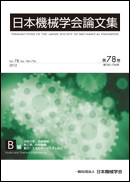Volume 78, Issue 796
Displaying 1-9 of 9 articles from this issue
- |<
- <
- 1
- >
- >|
Fluids Engineering
Regular Paper
-
2012Volume 78Issue 796 Pages 2054-2061
Published: 2012
Released on J-STAGE: December 25, 2012
Download PDF (925K) -
2012Volume 78Issue 796 Pages 2062-2075
Published: 2012
Released on J-STAGE: December 25, 2012
Download PDF (2042K) -
2012Volume 78Issue 796 Pages 2076-2086
Published: 2012
Released on J-STAGE: December 25, 2012
Download PDF (1346K) -
2012Volume 78Issue 796 Pages 2087-2095
Published: 2012
Released on J-STAGE: December 25, 2012
Download PDF (1511K) -
2012Volume 78Issue 796 Pages 2096-2112
Published: 2012
Released on J-STAGE: December 25, 2012
Download PDF (2398K) -
2012Volume 78Issue 796 Pages 2113-2126
Published: 2012
Released on J-STAGE: December 25, 2012
Download PDF (2326K)
Thermal Engineering
Regular Paper
-
2012Volume 78Issue 796 Pages 2127-2141
Published: 2012
Released on J-STAGE: December 25, 2012
Download PDF (2867K) -
2012Volume 78Issue 796 Pages 2142-2152
Published: 2012
Released on J-STAGE: December 25, 2012
Download PDF (3500K) -
2012Volume 78Issue 796 Pages 2153-2163
Published: 2012
Released on J-STAGE: December 25, 2012
Download PDF (662K)
- |<
- <
- 1
- >
- >|
